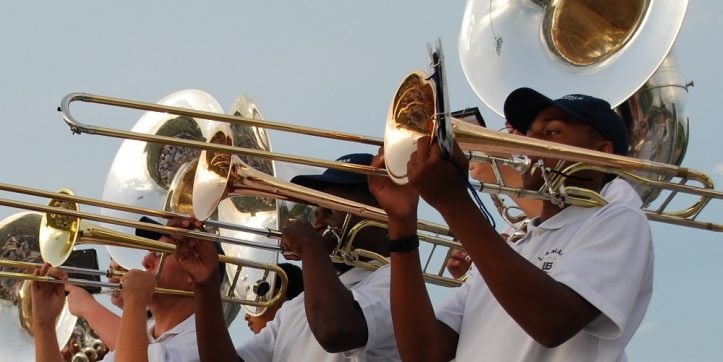Elimination of instrument fees sparks student involvement

As part of the 2014 Bond package, the AISD eliminated instrument fees for students in August 2014. This attempt to remove barriers so more students can participate in fine arts seems to have paid off immediately with increased student participation in the 2014-2015 school year. Bond funds are helping pay for the additional instruments and replace older instruments with higher quality pieces.
The AISD has an objective within its strategic plan, Achieve Today. Excel Tomorrow., that 100 percent of students will be actively involved in extracurricular and co-curricular activities. Participation statistics from last school year indicate the elimination of instrument fees is helping the district get closer to that objective. “Every one of our fine arts programs is growing,” said Dr. Jeremy Earnhart, AISD fine arts director.
For example, fifth- and sixth-grade strings enrollment increased 21 percent in 2014-2015 from the previous school year. Seventh-grade band enrollment increased 54 percent, and high school band enrollment went up 21.8 percent. Overall performing arts participation at the high school level, including band, choir, orchestra, theater, dance and drill team, increased 14 percent. Seventy-two percent of all AISD students, or 42,891 students, participated in some form of fine arts last school year.
But there is still room for more students in band, choir and orchestra. Thanks to the bond, the AISD is ready to grow in these areas and offer all students the opportunity to participate without any obstacles.
Increasing fine arts participation is important to the district. Not only do fine arts provide a more holistic educational experience for students, research shows that students in fine arts perform better in all areas of academics. As Earnhart likes to point out, expanding school music opportunities and access has a high return on investment for the entire district. It has the power to improve attendance, graduation rates and test scores. According to the College Board, students enrolled in four years of fine arts study score 11-13 percent higher on the SAT than students without fine arts study. And according to the Texas Music Educators Association, schools with higher enrollment in fine arts report higher graduation rates.
Numerous studies suggest music education has wide-ranging constructive affects, positively impacting brain development, math and verbal skills and overall academic achievement. One study, released in the “Journal of Neuroscience,” indicates that the neural coding of at-risk children improved after two years of instrumental music enrichment. “In other words,” Earnhart said, “instrumental music study has been found to close the neurological gap between children of poverty and their more privileged peers.”
The AISD recognizes the value of fine arts education for its students and is strongly committed to making those programs accessible to all students. The 2014 Bond package is helping fuel that commitment with $9.8 million over five years devoted to instruments, uniforms and music capital. In addition, the bond will fund the construction of a district wide state-of-the-art fine arts center, the creation of two fine arts/dual language academies and the addition of a strings room at every elementary school.
(A New York Times article, “Some schools embrace demand for education data,” on May 11, 2015, cited the AISD’s elimination of instrument fees and the resulting growth in band participation.)
